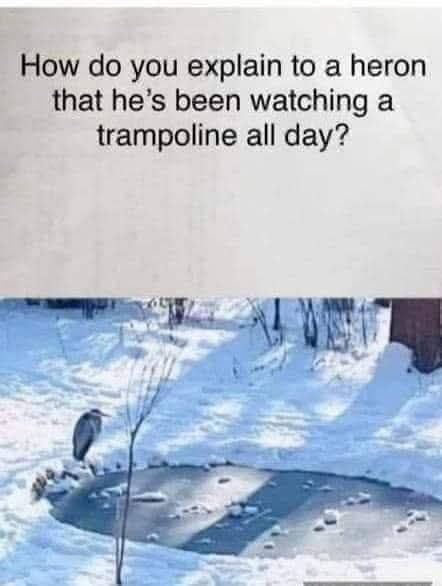Welcome to The Understory
A Newsletter About the Stories Beneath the Science
(Read to the end for a very relatable heron.)
The media universe is replete with science coverage, but there’s a gap between the stories we tell about science and what being a scientist is actually like. To me, that is where the most important science stories are.
When I started my career as a scientist in the late 2000s, I studied the plants under the canopy of high-elevation hardwood forests in the Appalachian Mountains. Some of my study subjects were overlooked herbaceous plants—a lone leaf sticking up from the soil, unable to flower because it was constantly eaten by deer. Others were tree seedlings and saplings—the future forest canopy. What happens in the shadow of the canopy affects the entire ecosystem and its future. The tiny and the overlooked and the marginalized matter.
I’m launching The Understory newsletter as a place to discuss the stories about science that our news cycle and cultural stereotypes miss.
I entered journalism in 2012, and at the time I thought better science communication would solve problems from climate change to vaccine hesitancy. I felt that the discourse in news outlets and on social media that I was observing fundamentally misunderstood me and my colleagues, and I wanted to change that. I still think that evidence-based science communication is important and necessary, but I also came to realize that deeper, structural problems in science and our information systems—not to mention society at large—were at the root of these wicked problems.
Once I came to this realization, I felt powerless to change such huge forces. I also felt complicit in these systems. How could I not be? Everyone was. Over time, I’ve come to terms with these conditions and have thought deeply about how to work toward justice. I’ve had to emotionally process the injustices I experienced in my career, as well as the many more I have witnessed happen to colleagues and sources. I’ve learned to follow Mr. Rogers’s advice and look for the helpers changing science for the better. We’ll do that a lot in these pages.
How I’m a Helper
This newsletter is an extension of the body of work I built while writing for American Scientist and a growing list of other platforms.
I have several areas of focus for this newsletter. Each intersects with long-term projects that I am working on.
First, I am interested in how power operates in science, and how that determines what our society knows. I have watched how the same topics of injustice come up repeatedly and barely change—whether that be the loss of mothers from science, the large power differentials between early-career scientists and their supervisors, the increasing reliance on contract labor, or the outsized burden of service and mentorship that faculty of color are expected to take on. I am particularly seeking solutions to entrenched structural problems and finding change-makers who are doing science differently.
This project is also an assessment about mythologies of science and how they influence eveyrone. To do so, I am collaborating with science and technology studies researcher (and my friend), Kristen Koopman. Kristen and I met about 10 years ago, when I sat in on her class on science fiction and philosophy of science at Virginia Tech. I needed a crash course on philosophy of science, but found philosophers’ writing to be generally a slog (No offense—every philosopher I have said this to has nodded sympathetically.) Reading sci-fi was a great carrot to go with the stick of academic philosophy.
Through Kristen’s class, I not only read classics from Isaac Asimov and Ursula K. LeGuin, but also listened to the absurdist podcast Welcome to Night Vale and watched Rebecca Sugar’s Steven Universe and Marvel’s Iron Man. At the time, Kristen was studying gender and science fiction, while the GamerGate movement descended upon the Hugo Awards. She is my go-to person for fiction recommendations, and I hope she will become yours as well.
This newsletter will regularly include a section called Koopman’s Corner, where Kristen will cover fun or thought-provoking speculative fiction and pop culture related to science.
A second topic area I am interested in covering is how scientists came to define life and well-being in a way that downplays the sensation of being alive, in contrast to many other Indigenous traditions that they must’ve encountered. I suspect that this history contributes to many problems, from the extinction crisis to overlooking people with chronic fatigue symptoms.
Third, I am interested in collecting oral histories about rapid environmental change. Because my PhD research centered on understanding how history can affect the long-term trajectory of a forest and landscape, I am well aware of how quickly data and memories about land—and the culture they uphold—can be lost, especially at such a chaotic and disruptive time. This project, called Second Growth, is a collaboration with digital producer Lisa Tossey and science communication professor Bethann Garramon Merkle.
Finally, I am interested in the practice of science writing and editing, and how this field is changing. It’s been a wild time to be in science and journalism. There’s a lot to discuss. A midcareer editor is launching a newsletter, for crying out loud. Welcome to 2025.
If you are interested in supporting these long-term projects, please tell me whether you would pay to subscribe here, and what sorts of subscriber perks interest you. I need to make sure I can cover costs before I upgrade my newsletter plan.
In the meantime, please subscribe to the free version and buy me a coffee here.
Recent Things I Wrote:
PhD scientists who forged a career off the beaten track, Nature Careers
Tracking the Trump Administration’s effects on science and health care, AHCJ
Recent Things I Recommend:
X Man: The Elon Musk Origin Story, by Jill Lapore
This is how universities can escape Trump’s trap, if they dare, by M. Gessen
Something Fun:

About Me:
https://authory.com/KatieBurke